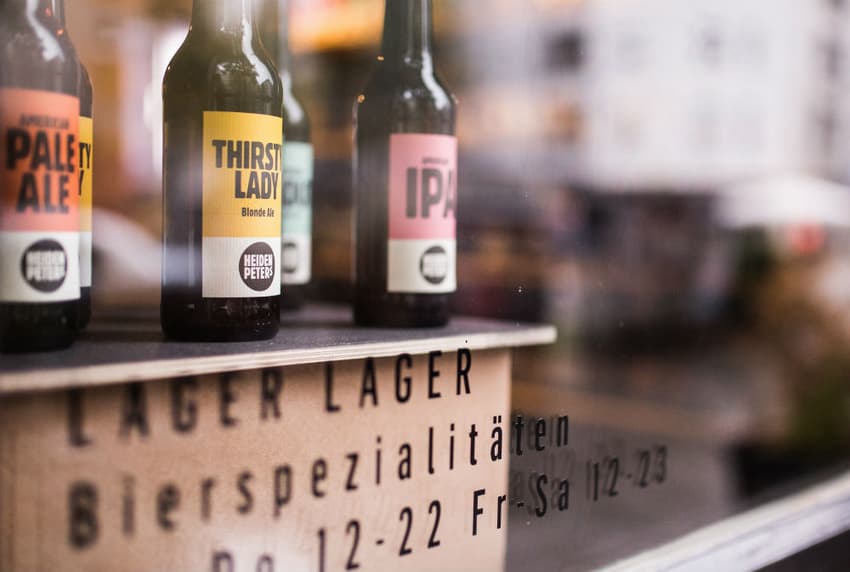Craft beer drives surge in new German breweries

Latest statistics from the German Brewers’ Association show that the number of German breweries is not only increasing across the country - so, too is the selection of beer.
Beer drinkers in Deutschland have an ever-expanding choice of brew available to them. Last year, 82 new breweries nationwide popped up. This is the same number of German breweries that were set up within an eight-year time span prior to 2017.
The trend for craft beer can account for why the number of breweries is on the rise, according to the association.
“The beer market in Germany is becoming increasingly diverse," said Holger Eichele, CEO of the German Brewers’ Association, adding that the beer the country offers is unparalleled in the world.
Germany's steadily growing variety of beer is partly due to the growing preference especially in urban centres toward smaller breweries offering specialty products such as flavoured types of craft beer, Eichele added.
Beer drinkers in Germany care more and more about the source and the story of the beer, beer blogger Geoffrey Dobbs wrote in an editorial for The Local last year, referring to growing tastes for craft and local beer.
SEE ALSO: Opinion - The German beer industry is failing to live up to its potential
There are now 1,492 breweries across the nation - more than at any point since the country reunited in 1990. But by the end of March, this number is expected to exceed 1,500.
Most of these breweries have in recent years been set up in the Berlin and Brandenburg area, figures from the Federal Statistical Office (Destatis) show.
Meanwhile Bavaria saw the largest number of new brewery openings (18) last year; across the state there are currently 642 breweries. Baden-Württemberg follows in second place with a total of 204 breweries and the state with the fewest breweries is Mecklenburg-West Pomerania (23).
Numerous other new players in the regional beer markets are helping to shake things up too, the association adds.
In spite of the brewery landscape diversifying, thirst for beer actually declined in 2017. German brewers sold two million fewer hectolitres (100 litres) of beer in 2017 than in the previous year. Exports also decreased.
Long-favoured traditions and tastes also die hard. By far the most popular beer in Germany is a Pilsner - a light beer developed in the 19th century. The Pilsner has a market share of about 50 percent, according to the German Brewers' Association.
Wheat and export beers have around eight percent of the market share, respectively, while strong growth has also been recorded in unfiltered cellar, land, gusset and light beers.
READ ALSO: 10 fascinating facts you never knew about German beer
Comments
See Also
Beer drinkers in Deutschland have an ever-expanding choice of brew available to them. Last year, 82 new breweries nationwide popped up. This is the same number of German breweries that were set up within an eight-year time span prior to 2017.
The trend for craft beer can account for why the number of breweries is on the rise, according to the association.
“The beer market in Germany is becoming increasingly diverse," said Holger Eichele, CEO of the German Brewers’ Association, adding that the beer the country offers is unparalleled in the world.
Germany's steadily growing variety of beer is partly due to the growing preference especially in urban centres toward smaller breweries offering specialty products such as flavoured types of craft beer, Eichele added.
Beer drinkers in Germany care more and more about the source and the story of the beer, beer blogger Geoffrey Dobbs wrote in an editorial for The Local last year, referring to growing tastes for craft and local beer.
SEE ALSO: Opinion - The German beer industry is failing to live up to its potential
There are now 1,492 breweries across the nation - more than at any point since the country reunited in 1990. But by the end of March, this number is expected to exceed 1,500.
Most of these breweries have in recent years been set up in the Berlin and Brandenburg area, figures from the Federal Statistical Office (Destatis) show.
Meanwhile Bavaria saw the largest number of new brewery openings (18) last year; across the state there are currently 642 breweries. Baden-Württemberg follows in second place with a total of 204 breweries and the state with the fewest breweries is Mecklenburg-West Pomerania (23).
Numerous other new players in the regional beer markets are helping to shake things up too, the association adds.
In spite of the brewery landscape diversifying, thirst for beer actually declined in 2017. German brewers sold two million fewer hectolitres (100 litres) of beer in 2017 than in the previous year. Exports also decreased.
Long-favoured traditions and tastes also die hard. By far the most popular beer in Germany is a Pilsner - a light beer developed in the 19th century. The Pilsner has a market share of about 50 percent, according to the German Brewers' Association.
Wheat and export beers have around eight percent of the market share, respectively, while strong growth has also been recorded in unfiltered cellar, land, gusset and light beers.
READ ALSO: 10 fascinating facts you never knew about German beer
Join the conversation in our comments section below. Share your own views and experience and if you have a question or suggestion for our journalists then email us at [email protected].
Please keep comments civil, constructive and on topic – and make sure to read our terms of use before getting involved.
Please log in here to leave a comment.